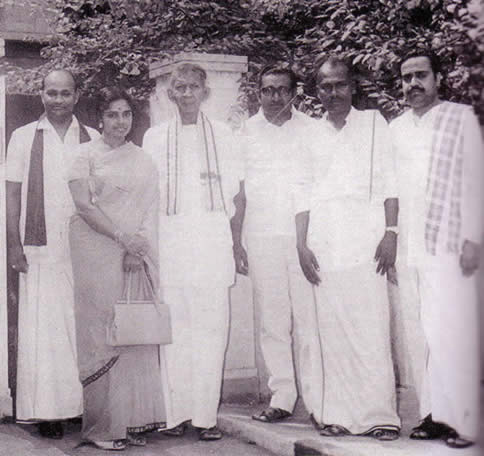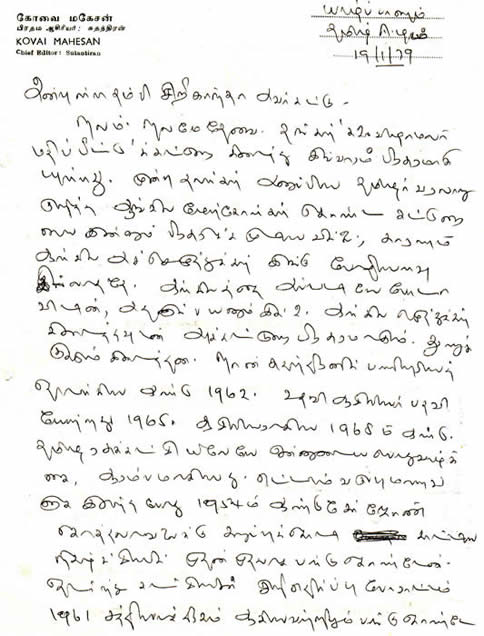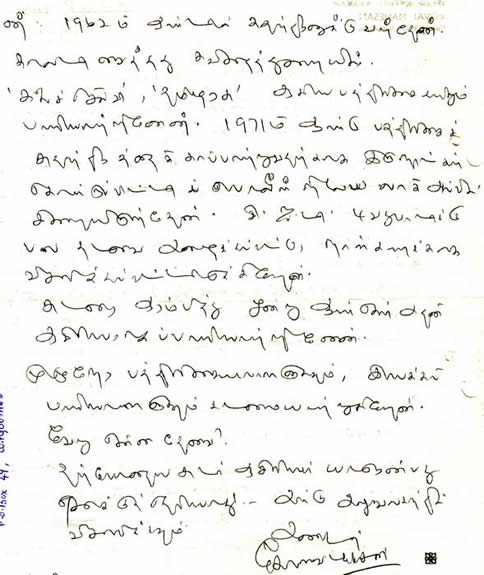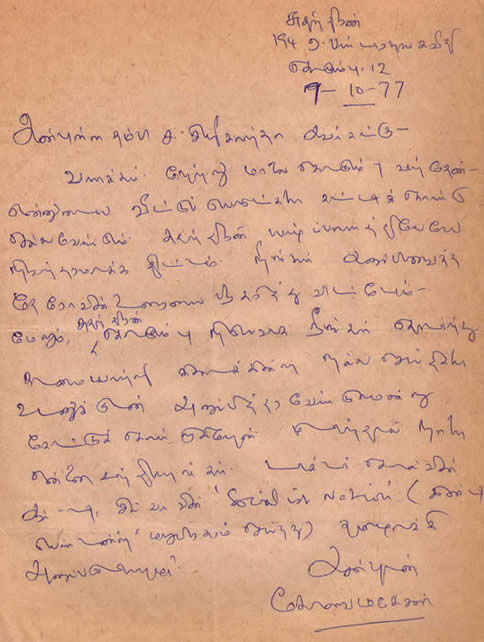Ilankai Tamil Sangam29th Year on the Web Association of Tamils of Sri Lanka in the USA |
|||
 Home Home Archives Archives |
Remembering Kovai Mahesan (1940-1992)My first mentor in journalismby Sachi Sri Kantha, July 10, 2012
Twenty years had passed since Kovai Mahesan (one of the colorful Eelam Tamil journalists in the last quarter of the 20th century) died on July 4, 1992 in Tamil Nadu, India. He was born Maheswara Sarma in Kopay, Jaffna, and was 52 at the time of his premature death. I consider him as my first mentor in journalism. With the exception of a few, not many remember him now. Whereas the Tamil journalists of his generation who were employed in news establishments owned by Sinhalese moguls lacked the will and spine to address the issues affecting the Tamil lives, Kovai Mahesan was an opposite for a 15 year period (1968 to 1993). Quite a section of Tamils, including the journalists, who lacked the courage for confrontational politics (or polemics, if his detractors termed it), found it difficult to taste Kovai Mahesan’s journalism. He was also one of the survivors of the infamous Welikade prison massacre in July 1983.
A scanned photograph I provide nearby was taken in 1972, when S.J.V. Chelvayakam (the leader of Federal Party) visited Tamil Nadu. We see Kovai Mahesan (at extreme right) in the company of Chelva. He would have been 32 then. Kovai Mahesan was the editor of Sutantiran, the weekly newspaper owned by Chelva’s family for almost 15 years. Other personalities seen in the photo are (from left): A. Amirthalingam, Mrs. M. Amirthalingam, Chelva, A.P. Janarthanam (student leader of DMK, and later affiliated with MGR’s Anna DMK) and A.S. Manavaithambi (Indian Tamil leader in Sri Lanka, who later returned to India). This was taken on the occasion when Chelva and Amirthalingams visited Anna’s (C.N.Annadurai, that is) house. Eulogy in 1992 My brief eulogy to Kovai Mahesan appeared in the print edition of Tamil Nation (August 1992), which I reproduce below.
Two Letters from Kovai Mahesan I still keep a few letters Mahesan and I exchanged in the late 1970s. I provide scans of two of them here. In one (dated January 19, 1979), he described his profile. I provide a Tamil translation. Then, he was living in Jaffna. If memory serves me well, Kovai Mahesan was the first Tamil journalist to be harassed by the Sri Lankan police and law enforcement investigators in Colombo in 1970s. Why I solicited his profile? As a precautionary measure (knowing that he was one of the marked Tamil activists of that era) I wanted to collect his profile directly from his own hand.
C.I.D. stands for Criminal Investigation Department in Sri Lankan lingo. The ‘Fourth Floor’ of C.I.D. is a metaphor among Tamils for rigorous drilling and torture (both physical and mental) experienced by those who were invited to this nasty location. In a previous letter to me, written in October 7, 1977 (which shows its 35 year old age due to browning!), Mahesan had written:
What Mahesan had written about “Thero’s speech” refers to a speech made by Ananda Mangala Thero at a meeting held the Thurston Hall, Colombo, under the auspices of the Ceylon Rationalist Society. As a member of this society, I was present at that meeting. This Buddhist priest (then visiting from Singapore) made a speech in good English, which was filled with bile. The title of his speech was ‘One Country, One Nation, Many People’. His featured target was my debut commentary on the 1977 general election results about how the Eelam Tamils had voted for the TULF, which appeared in the Tribune (Colombo) of Aug.27, 1977. I did learn a lesson from that episode which happened 35 years ago, that my English writing (the themes I chose and/or the style of presentation) did posssess the power to influence or irritate people’s thought process. It is better to be read, rather than being ignored! After the death of S.J.V. Chelvanayakam in April 1977 and the Sinhala-Tamil riots in August 1977, the then publisher S.C. Chandrahasan [son of Chelva] opted to move Sutantiran’s production from Colombo to Jaffna. And Kovai Mahesan moved to Jaffna. In between, in May 1977, I also moved from Colombo to Peradeniya. Though being a weekend visitor to Colombo, to the best of my ability, I fulfilled the request made by Kovai Mahesan to function as Colombo reporter to Sutantiran. It was an honorary job. In those days, not many big-name Tamil journalists or big-name Tamil writers were willing to work (for poor pay!) or to be identified with Sutantiran (for reasons of police harassment and to project their image as non-partisan neutrals). They wouldn’t touch Sutantiran with a barge pole. Even if their names appeared as a byline in Sutantiran, they ridiculously felt that they would be noted by the Colombo gumshoes and their job opportunities in Colombo would dry out. In Sivanayagam’s 2005 Memoir Kovai Mahesan receives occasional mention in journalist S.Sivanayagam’s 2005 memoir [Sri Lanka: Witness to History – a journalist’s memoirs (1930-2004)], as a survivor of the infamous Welikade Prison massacre of 1983, and as an activist in Tamil Nadu since July 1983. Sivanayagam also recorded the reason why Mahesan had to land in Welikade prison. According to him, there was a bomb blast on a train carriage and Mahesan, along with Dr. S.A.Tharmalingam who had formed a ginger group of TULF, called TELF (Tamil Eelam Liberation Front) was taken to Colombo from Jaffna, for questioning. The third prominent individual of TELF group was M.K.Eelaventhan (K. Kanagendran). Sivanayagam had written, “It was either a stupid mix-up on the part of the government intelligence that they could not distinguish between the propagandist TELF and the Tamil Eelam Liberation Army (TELA) which was a small, negligible armed group, or it was a deliberate frame-up because the TELF had called for a hartal in protest against the [June 1983] Trincomalee killings, and had sent letters to several diplomatic missions in Colombo pressing the demand for a United Nations Peace Keeping Force to safeguard Tamil lives.” In sum, Kovai Mahesan was a good writer of Tamil prose and remained as a good fighter for Tamil rights until his death. His writing did pinch the nerves of Colombo’s gumshoes occasionally and not many of the Tamil journalists of his era can boast about this merit. *****
|
||
|
|||



